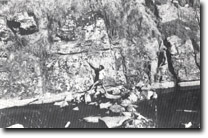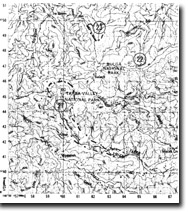21. Tarra Valley National Park
|
This information has been developed from the publications:
|
| Location: | 595450 to 630413. |  Cretaceous sandstone, Tarra River. Hammer indicates holes where 'cannon ball' concentrations have been weathered out. |
Access: | Tarra Valley Road, Grand Ridge Road. | |
Ownership: | Crown Land (Tarra Valley National Park). | |
Geology/Geomorphology: | The National Park includes examples of the deep valleys that are the typical terrain of the South Gippsland Hills. Cretaceous sandstones outcrop in the streams forming rapids and waterfalls, adjacent to the road south of the Park. | |
Significance: | State. The area is of particular interest for hydrological studies as it contains small catchments that have not been heavily logged. | |
Management: | Continued management by the National Parks Service should allow the site to retain its high significance. | |

Sites 8221-21 22 23


